Stoner 63: Eugene Stoner's modular weapon system
After ArmaLite sold Colt's AR-15 manufacturing rights, Eugene Stoner began work on another armory a system that would not infringe on patents obtained for the AR-10 and AR-15 rifles. The result was an automatic rifle AR-16 chambered for 7.62x51 mm, but it did not go into the series. The reason was the growing interest in the low-pulse cartridge 5.56 × 45. ArmaLite decided to redesign the AR-16 for a promising low-pulse munition. The task was received by Arthur Miller (Arthur Miller), who in the period 1963-1965. developed a version of the Stoner rifle under 5,56 × 45 rounds. A number of improvements were made to the design, and the rifle received the designation AR-18. Thanks to working with weapons systems under the 5.56 × 45 cartridge, Arthur Miller received the position of chief engineer of ArmaLite, which remained vacant after the departure of Eugene Stoner.
The AR-18 rifle was produced at different times in Japan and the UK, both for the armed forces and for the civilian market. A certain number of rifles fell into the hands of terrorists. So, AR-18 was often used by IRA militants, so this rifle is better known under the nickname "Widowmaker" ("Widowmaker").
Not all readers know that when registering ArmAlite (01.10.1954), the full name of the company was: “ArmaLite Division of Fairchild.” That is, at first ArmaLite was a division of Fairchild Engine and Airplane Corporation. The same Fairchild Corporation, which later developed and manufactured the A-10 Thunderbolt II attack aircraft, armed with a 7-barrel gun.
In 2010, Fairchild was acquired by the US division of Elbit Systems. But this is already in the 21st century. And in the 50s of the last century, the corporation expanded, its leaders decided to occupy a niche in the small arms market, so they invested in the creation of a new company called ArmaLight.
After leaving ArmaLite, Eugene Stoner joined the parent company Fairchild, but did not work there for long. Perhaps they did not agree or did not allow to realize their own achievements. Therefore, Eugene Stoner began to look for a manufacturer for whom he could develop a new rifle, the concept of which he had long pondered. Paul Van Hee, Cadillac Gage's Sales Director, arranged for Stoner to meet with a vice president named Howard Carson.
It is noteworthy that both ArmaLite and the Cadillac Gage branch were located next door in the city of Costa Mesa (USA, California).
At the meeting, the designer offers the concept of his new weapons complex. Mr. Carson became interested in the concept of Stoner, and invited him to discuss his project with Mr. Russell Bauer, president of the parent plant of Cadillac Gage (Warren, USA, Michigan).
The concept of the Stoner weapons complex was to develop interchangeable modules and a series of interchangeable barrels. According to the designer’s idea, thanks to a single base (bolt box) and interchangeable kits, fighters will be able to quickly assemble, even in the field, several types of small arms: a carbine, an assault rifle or a machine gun.
Looking ahead, I inform you that the first test batch of experimental weapons for the US Department of Defense was made in 1963, so this system was designated the Stoner 63. By the way, in the mid-70s, the Steyr AUG weapon system was developed in Austria. It was also built on a modular scheme, but received much greater fame and distribution.
As a result of a series of meetings and negotiations with top managers of the Cadillac Gage, Eugene Stoner moves to work in this company. The most famous development of Cadillac Gage Corporation, is a wheeled armored personnel carrier "Commando" (M706). By the way, the Cadillac Gage in 1986 was acquired by Textron Corporation. Currently, the Textron conglomerate includes companies such as Bell Helicopter, Cessna, Lycoming and others. And yes, the Cadillac Gage has nothing to do with luxury cars or General Motors.
In the Cadillac Gage, Eugene Stoner does not begin work on yet another assault rifle, but on a whole range of small arms. After all, the designer already in the process of developing weapons of the AR-10/15 family already had new ideas and developments for the future.
Take at least two experimental light machine guns created on the basis of the AR-10 rifle: with the store-fed AR-10 Squad Automatic Weapon (SAW), and with the tape AR-10 belt-fed Light Machine Gun (LMG). By the way, the AR-10 LMG version was developed in the Netherlands, at the company Artillerie Inrichtingen (AI). The fact is that in 1956 the Netherlands decided to establish a licensed production of AR-10 on its territory and rearm its armed forces with a Stoner rifle. Eugene Stoner traveled to the Netherlands to assist in the translation of documentation to the metric system, to make design changes according to customer requirements and to start production. As a result, some components and mechanisms of the AR-10 were redesigned, a number of prototypes and prototypes were manufactured. The early version of AR-10 was significantly improved in the Netherlands, and many solutions took root on later versions. One of the modifications of the AR-10, redesigned at Artillerie Inrichtingen (AI), was purchased by Cuba and Sudan. Therefore, this modification is often called “Cuban” (Cuban) or “Sudan” (Sudanese).
Stoner m69w
Several years have passed since the development of the .223 Remington cartridge (5.56 × 45), but at that time it was not yet considered a military munition. It is said above that up to this point, Eugene Stoner had never worked with this cartridge. Therefore, as in the case of the AR-10, he designed his new prototype under the good old cartridge 7.62x51 (.308 Winchester).
To work on a new project, Eugene Stoner lured two of his most talented assistants out of ArmaLite. These are Robert Fremont and James L. Sullivan. Both of them proved themselves during the design of rifles from AR-1 to AR-15. Frankly, gentlemen Fremont and Sullivan, like Eugene Stoner, are the equivalent creators of the AR-15 rifle: from the first prototype with the designation X AR 1501 to the start of mass production of the finished model.
Their names are mentioned much less frequently in connection with Stoner's developments, although their role can hardly be overestimated. In order not to belittle anyone’s merit, I will describe the tasks that the main team members performed.
Eugene Stoner generated concepts. James Sullivan designed designs (drawings) for Stoner's concepts. Robert Fremont supervised the production of prototypes and the organization of production processes. That is, he was a technologist.
Also, gentlemen Fremont and Sullivan took part in finalizing the new .223 Remington cartridge, which will later become known to 5,56 × 45 mm NATO.
There are two opinions.
1. Eugene Stoner came to the Cadillac Gage with the goal of developing a machine gun for the US Army (hence the 7.62 caliber). However, in the process, the designer proposed a whole family, built according to a modular scheme.
2. The idea of a modular complex came to Eugene Stoner during his work on the AR-10 and AR-15. Since ArmaLite began to have financial problems, and there was no time for new projects, the designer found another weapons company that agreed to provide him with everything necessary.
The author of the article considers version 2 correct.
Yes, in 1959 ArmaLite sold its rights to Colt's AR-15 due to a bunch of difficulties. But I propose to study the photo of the first prototype (M69W), which was already made in the Cadillac Gage, after Stoner's departure from ArmaLite.
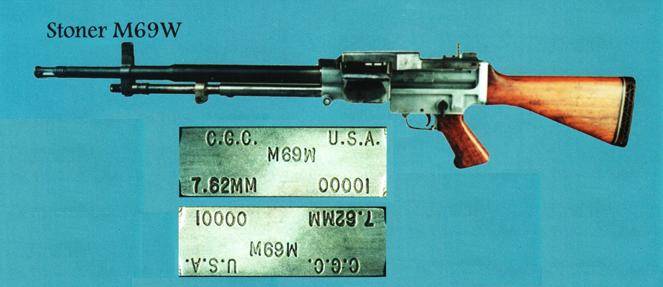
The photo above shows an enlarged marking from the receiver, with serial number 00001. The abbreviation CGC means the name of the manufacturer (Cadillac Gage Corporation). Marking M69W does not mean a year of adoption. This is an ambigram. That is, an inscription that can be read upside down. According to the idea of the designer, the ambigram symbolizes the ability of the bolt box to work upside down (read more about this below). The first working prototype of the future Stoner 63 complex was developed under the 7.62 × 51mm NATO cartridges (as well as the AR-10).
Apparently, the receiver is made on a milling machine. On the side we see the receiver window for tape power. That is, in front of us is clearly a machine gun under intermediate cartridges. One gets the impression that the barrel of the machine gun is fixed: no visible mounts, no handles for quick replacement. That is, at the prototype stage, there was no talk of any modularity. However, in the ambigram (M69W), the designer as if hints at an unusual design. Most likely, the implementation of modularity was planned in subsequent stages. That is, already in the process of transition from a prototype to a more technologically advanced product suitable for mass production.
You must admit that a milled receiver is a heavy and expensive part. In addition, its production requires a lot of time and skilled machine workers. Most likely, in order to simplify and reduce the cost of the production process, as well as reduce the weight of the product structure, a perforated metal shutter box was developed for the next prototype. Indeed, in the production of AR 15 of the same Eugene Stoner, stamping was already widely used. The same opinion is shared by the authors of the book "Assault Rifles of the World" Harry Paul Johnson and Thomas W. Nelson. The following is a translation from English excerpts from the specified book.
Initially, on the basis of the M69W system, a modification of the machine gun with tape power (LMG) was developed. But soon 2 products were also manufactured in the configuration of a light machine gun / assault rifle. That is, these prototypes of the M69W system had a combined type of ammunition, which was carried out either by tape or by stores. Changing the configuration and type of ammunition was achieved by replacing several components and assemblies.
It was supposed to produce pre-production products from stamped sheet metal, but the first prototypes of the M69W were made on machined aircraft alloy machines. There is evidence that at first the 7075 / T6 alloy was used, but over time, James Sullivan developed and patented the Sulliloy (Sullivan Alloy) alloy on its basis.
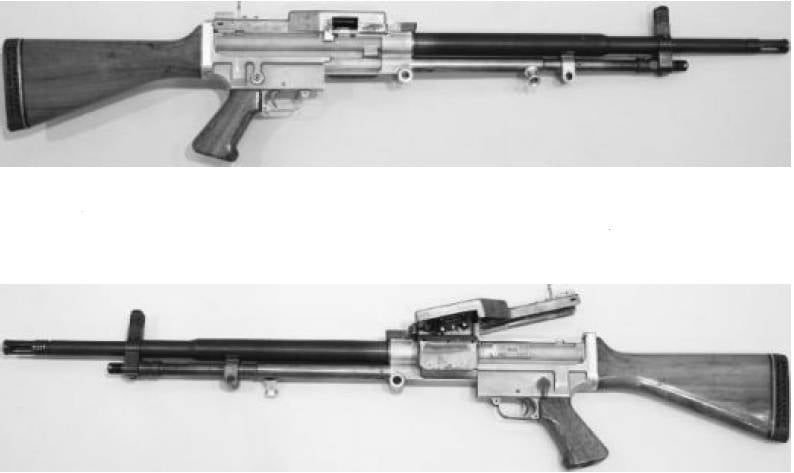
The gentlemen of the Cadillac Gage were impressed by the prototypes, and on November 6, 1961, the company signed a license agreement with Eugene Stoner. Already in December, next to the main plant in the city of Costa Mesa, a small factory (workshop) was opened specifically for the implementation of the Stoner project. By that time, a modified version of the M69W product was already ready.
stoner 62
Like the M69W, in Stoner 62 the operation of automation is also based on the removal of powder gases from the bore to the gas chamber, in which they act on the piston, which drives the shutter frame. Locking occurs by turning the shutter, 7 fighting stops. The gas vent mechanism is characterized by a long stroke of the gas piston.
Stoner 62 was made of stamped sheet metal. In his development, Stoner was helped by James Sullivan and Robert Fremont. Like the M69W, the Stoner 62 was a rifle that could be converted into a tape machine gun.
The Stoner 62 was produced in a single set (1 receiver), several barrels, and interchangeable modules in order to configure an assault rifle, a tape machine gun, and an easel machine gun. The photo below shows the various configurations.



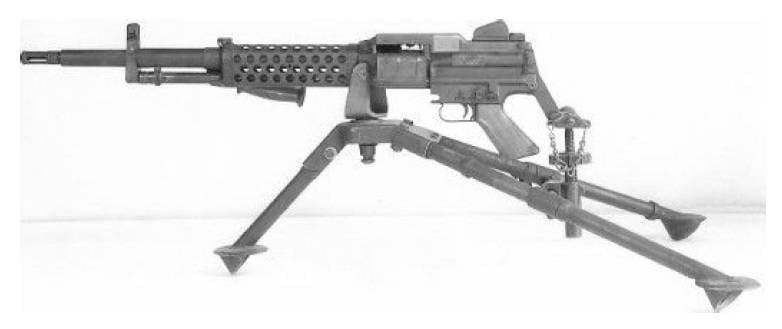
On the M69W and Stoner 62 systems, in the “belt powered machine gun” configurations, the same M13 cartridge belt was used as in the single M60 machine gun.
stoner 63
Due to the continuously growing worldwide interest in the .223 Remington cartridge (5,56x45 mm), the Stoner 62 was an intermediate product. Therefore, the Cadillac Gage decided to adapt the weapon to a new cartridge. Eugene Stoner (as in the case of AR-15) again entrusted this work to L. James Sullivan and Robert Fremont. The result was the Stoner 63. This product is very similar to the Stoner 62, except for its dimensions and the ammunition used.
The first Stoner 63 prototype in the “rifle” configuration was ready in February 1963. Stoner 63 also made extensive use of sheet metal and stamping technology.



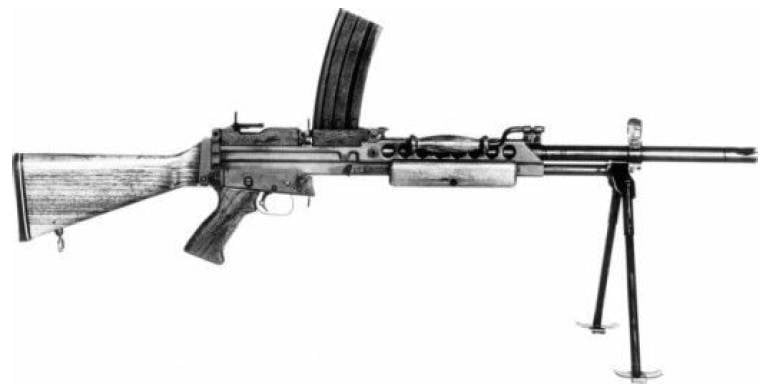
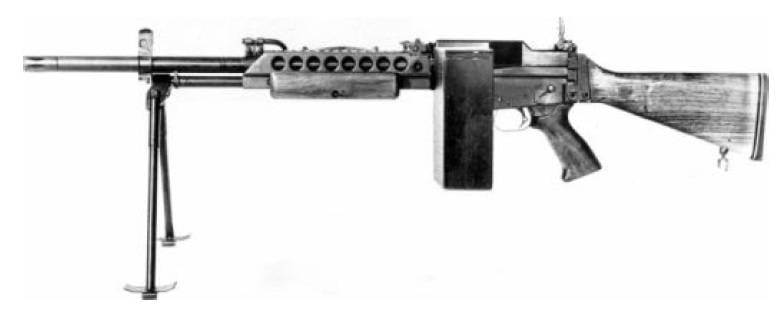
While working on Stoner 63, the tasks of Eugene Stoner's colleagues became different. So, Robert Fremont was appointed responsible for the development of modules for the configuration of "machine gun with tape power." That is, he became the head of the subproject. And James Sullivan led the team, which developed the nodes for the configuration of the "machine gun with store-fed."
Upon completion of the work, the metal on all samples was coated with a certain synthetic material (finished in a black synthetic) called Endurion, which gave the metal a black color. Perhaps an analogue of burnishing. Whereas in the early Stoner 63, butts and other fittings were made of walnut, in later specimens they were black in color, made of fiberglass reinforced polymer.
A month later, on March 4, 1963, Cadillac Gage received an order from the US Department of Defense for a batch of 25 Stoner 63 units in various configurations for testing. The order amount was $ 174,750. Already in April, at the base of the Marine Corps of El Toro, demonstration firing of the Stoner 63 was organized in the configuration of a "machine gun with tape power". The results of the firing were closely watched by General Lew Walt.
His full name is Lewis William Walt. At that time, Lew Walt rose to the rank of 4-star general, which corresponds to the rank of admiral. He was a combat officer, took part in the 2nd World War, the Korean War and the Vietnam War. He was repeatedly awarded medals, and twice for outstanding heroism he was awarded the US Naval Cross (the highest award of the Navy). The future general Walt received one of the Navy crosses for leading the attack on the Aogiri Range, at the Battle of Cape Gloucester (New Britain, in the Pacific Ocean). The purpose of the operation was the capture and subsequent operation of two Japanese military airfields. After a successful operation, the captured Aogiri Range was renamed Walt's Ridge (Walt Range). That is, he began to bear the name of the future general. This was General Lew Walt, who was present at the demonstration fire of the Stoner 63 machine gun.
From August to September 1963, Stoner 63 products in all configurations were tested at the Marine Corps Research Center (Quantico, Virginia, USA). The new weapon of the Stoner system made a positive impression with its light weight and ammunition efficiency. Most of all, the Marines liked the “rifle” and “belt powered machine gun” configurations.
However, the Stoner 63 system has not been tested. Representatives of the Marine Corps, the Army and the US Air Force have proposed a number of improvements. The modernization process dragged on and took more than 3 years. In order to comply with the chronology, other developments based on the Stoner 63 system will be described below. A description of the upgraded products that have received the Stoner 63A designation will follow.
Stoner 63 LMG Pod
In 1963, a young apprentice of Eugene Stoner left ArmaLite and followed his mentor at the Cadillac Gage. His name was Robert Gaddis. A little earlier, the Combat Dragon program launched to create a lightweight two-seat attack aircraft. It arose because of the war in Vietnam. In the conflict zone, a counter-guerrilla aircraft was required, which should have been equipped with small arms as well. They planned to arm the new model of the armored aircraft Cessna A-37 Dragonfly with hanging machine-gun containers. In the documents of those years it was designated AT-37. Perhaps because it was developed on the basis of the training Cessna T-37 Tweet. Thus, adding the designations A-37 and T-37, received the AT-37.
Already on October 9, 1963, Cadillac Gage received an order from the US Air Force for the manufacture of 2 experimental machine-gun installations in suspended containers. In each container, it was required to install 3 machine guns.
The basis was proposed to use the Stoner 63 with tape power. The new team member, Robert Gaddis, was appointed responsible for the project. The US Air Force order was completed. A young student of Eugene Stoner was able to quickly develop and construct everything necessary, according to specifications. In foreign literature, these products are called "experimental Stoner 63 Machineguns." It was planned to hang them in pairs, to the pylons under the wings of aircraft.
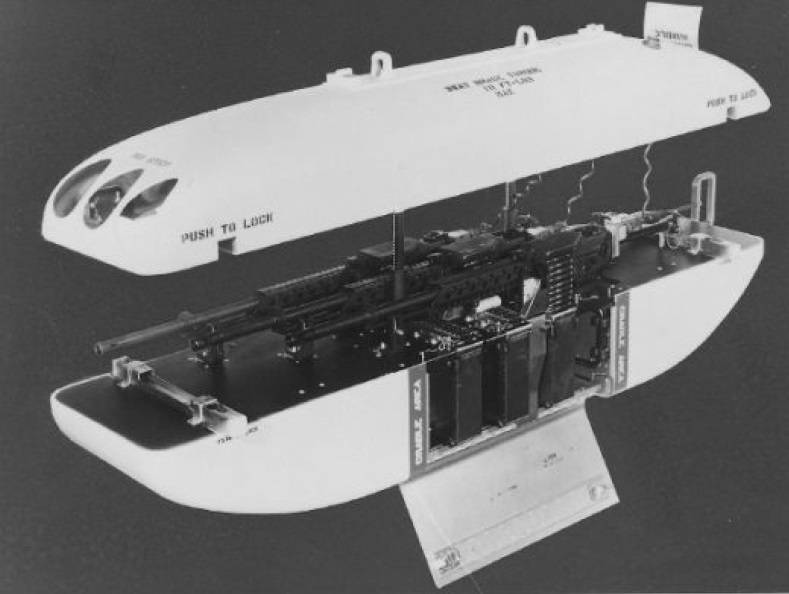
As you can see, each machine gun is located a little behind the next one after it. Thus, the designer provided the container with compactness, as well as easy access to cartridge boxes with ribbons. Each tape contained 100 rounds. That is, the ammunition was 600 rounds of ammunition for 6 barrels. The machine gun rate was about 750 rds / min. If we assume that all the machine guns worked simultaneously, as on Alexander Pokryshkin’s Aero Cobra, it would be quite an impressive second volley and firepower.
But it was smooth on paper, but forgot about the ravines. Rather, about thickets in ravines. Now every gun lover knows that the 5.56 NATO bullets are good, provided that there are no obstacles in their path. And if the bullet passes through the vegetation, it changes the trajectory, it can lose both speed and lethal force. Do not forget that at that time 5.56 mm cartridges were completely new. About this "side effect" was not yet known, since the weapons for this munition did not really participate in real hostilities. The attack aircraft were to wage a counter-guerrilla war mainly over the jungle. Therefore, it would hardly always be realistic to hit targets through dense thickets. Unless lead a harassing fire.
The machine gun tests of the Stoner 63 LMG Pod were carried out on the basis of the Eglin Air Force (California, USA). They were installed not only on the jet A-37 Dragonfly, but also on the piston North American T-28 Trojan. The installation of the Stoner system did not suit the customer. But not because of low-pulse cartridges, but because of permanent defects in the cartridge strip. In the original source indicate the break of the tape (belt separation). As a result, the Air Force command abandoned these installations, and the Stoner 63 LMG Pod project was closed. And instead of the 5,56-mm Stoner machine guns, the A-37 Dragonfly attack aircraft armed with multi-barrel M134 Minigun 7,62 mm caliber. In the countries of Latin America, a certain amount of Cessna Dragonfly is still in service.
The author turned to Bongo (Sergey Linnik) for comment regarding defects in cartridge strip on the Stoner 63 LMG Pod. Sergei modestly admitted that he is not an expert on this topic. He only suggested that the cause of tape breaks could be the vibration that occurred during firing. In the machine gun installation there were 3 machine guns. And each of them when shooting created oscillations that overlapped each other. There was a resonance, as a result of which the cartridge strip could not withstand the loads, and it collapsed.
The author agrees with Sergey and believes that the cartridge strips could be destroyed due to their imperfection. They were just raw at that time. The fact is that the 5,56 × 45 mm cartridge belt for ammunition was developed specifically for the Stoner machine guns with tape power. In the American nomenclature, this tape was designated M27. It is a practically reduced copy of the tape M13 for cartridges 7,62 × 51 mm to a single machine gun M60. Over time, due to the widespread distribution of 5,56 × 45 ammunition, the M27 cartridge belt was used in the FN Minimi and M249 SAW light machine guns. The M27 tape became widespread in the 1980s as a result of the adoption of 5,56 × 45 ammunition by NATO countries.
The author thanks Bongo (Sergey Linnik) for the consultation.
To be continued ...
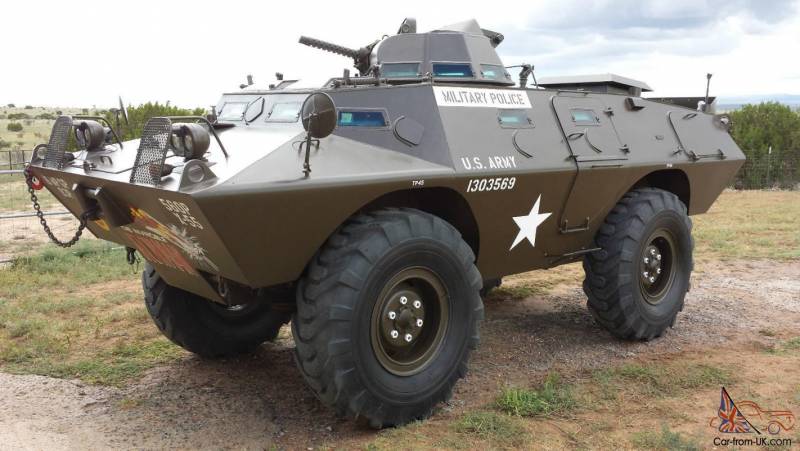


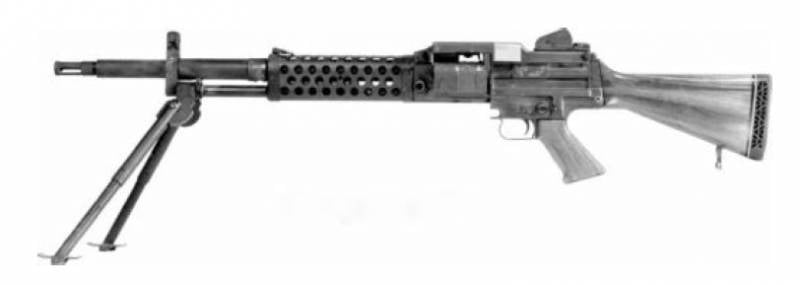
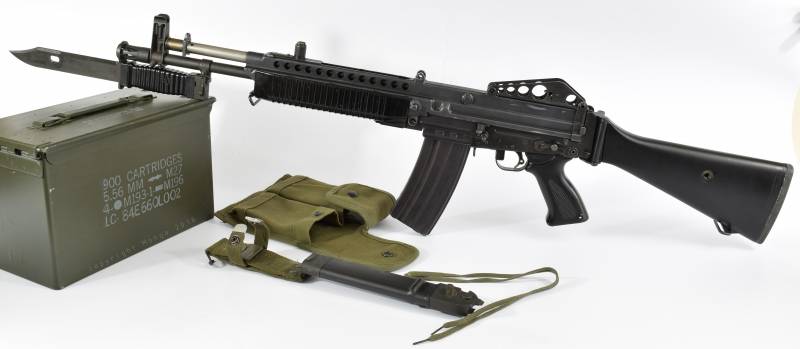
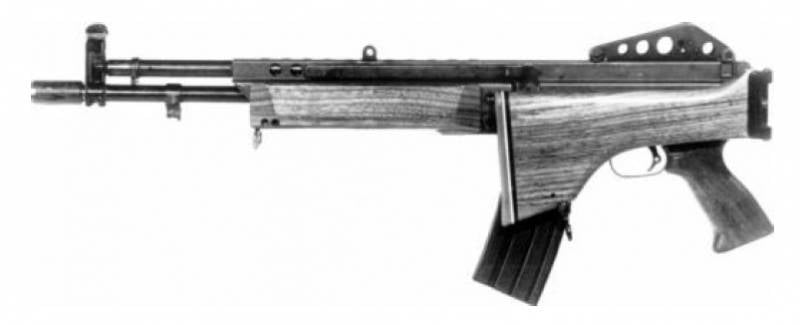
Information